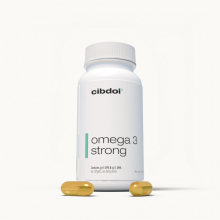Which is Better - Omega-3 or Omega-6?
Published:
Omega-3 and omega-6 fatty acids play important roles in the body. But which one is healthier for you? Omega-3s and omega-6s have different effects, and the balance between them is key. Let's objectively compare omega-3 vs omega-6 fats and which one comes out on top for optimal health.
Contents:

What Are Omega-3s and Omega-6s?
Omega-3 and omega-6 fatty acids are polyunsaturated fats the body needs but cannot produce on its own. They must come from the diet.
Omega-3 Fatty Acids
The main omega-3s involved in human physiology are:
- ALA (alpha-linolenic acid)
- EPA (eicosapentaenoic acid)
- DHA (docosahexaenoic acid)
ALA is found in plant sources like nuts and seeds. EPA and DHA come from marine sources like fatty fish.
Omega-6 Fatty Acids
The primary omega-6 fat is linoleic acid (LA). Major dietary sources include:
- Vegetable oils like soybean, corn and safflower oil
- Nuts and seeds
- Poultry and eggs
While both essential, omega-3s and omega-6s have vastly different functions and effects in the body.
Benefits of Omega-3 Fatty Acids
Here are some of the evidenced-based health benefits offered by omega-3s:
- Reduce inflammation and inflammatory diseases
- Support brain development and function
- Improve mood and reduce depression
- Enhance eye health and vision
- Promote heart health and lower heart disease risk
- Improve cholesterol profile and triglycerides
- Ease joint pain and improve mobility
- Support healthy pregnancy and infant development
Omega-3s act as potent anti-inflammatories and provide a wide range of whole-body benefits.
Benefits of Omega-6 Fatty Acids
Linoleic acid, the primary omega-6, also provides vital functions:
- Maintains skin health and reduces water loss through the epidermis
- Precursor of arachidonic acid needed to produce eicosanoids like prostaglandins
- Provides calories and energy
- Supports growth and development
- Helps regulate metabolism
So omega-6s also serve important roles, but are more generalized compared to the targeted health effects of omega-3s.
Omega-3 vs Omega-6: Key Differences
Omega-3s and omega-6s differ in the following key ways:
Anti-Inflammatory vs Pro-Inflammatory
Omega-3s reduce inflammation, while omega-6s promote inflammation in excessive amounts. This drives their distinct effects.
Improves vs Worsens Mental Health
Omega-3s boost mood and depression. But excess omega-6 intake is linked to worsening depression, anxiety, aggression and memory.
Lowers vs Raises Heart Disease Risk
Higher omega-3 consumption lowers heart disease mortality. But excessive omega-6 intake raises heart disease death risk.
More Potent Nutraceutical Properties
Omega-3s have more potent medicinal effects at lower doses compared to omega-6s. They don’t need massive amounts to provide benefits.
Why Omega-3/6 Balance Is Key
Both omega-3s and omega-6s perform important jobs. The issue arises when their balance is out of whack.
For optimal health, omega-6 intake should not dramatically exceed omega-3s.
Historically, humans evolved eating an omega-6 to omega-3 ratio close to 1:1. Today, the typical Western diet provides a ratio around 16:1, heavily skewed towards omega-6!
Excess omega-6 consumption leads to:
- Increased bodily inflammation
- Raised heart disease risk
- Worsening mental health issues
- Greater risk of chronic diseases
Rebalancing your omega-3 to omega-6 ratio closer to 1:1 or 2:1 can reduce incidence of these modern health problems.
Tips to Improve Omega-3/6 Balance
Follow these evidenced-based tips to improve your omega-3 to omega-6 balance:
- Reduce vegetable oil consumption. They are very high in omega-6.
- Increase omega-3 rich fatty fish intake to 2-3 times per week.
- Incorporate omega-3 foods like walnuts, flax and chia seeds daily.
- Take an omega-3 supplement like fish oil. Most people don’t eat enough omega-3 foods.
- Limit processed and fried foods. They skew ratios in favor of omega-6.
- Choose pasture-raised eggs and meat. They contain more omega-3s than conventionally-raised.
With a concerted effort, you can restore a favorable omega-3 to omega-6 balance.
Which is Healthier: Omega-3 or Omega-6?
When you weigh all the evidence, omega-3 fatty clearly come out on top as the healthier choice for most people:
- More potent anti-inflammatory and disease-fighting properties
- Uniquely boost mental health and cognitive function
- Reduce risk for the top causes of death like heart disease
- Overall more targeted therapeutic health benefits
Omega-6s are still essential in moderation. But most modern diets contain excessive amounts, and omega-3 intake is often inadequate.
Prioritizing omega-3s from seafood, plant sources or supplements confers powerful benefits for both physical and mental wellbeing.
Which is Better - Omega-3 or Omega-6? Conclusion
Both omega-3 and omega-6 fatty acids play important physiological roles. But omega-3s like EPA and DHA confer more potent and targeted health benefits ranging from enhanced cognitive function to protection against heart disease and depression. They act as strong anti-inflammatories. In contrast, excessive omega-6 consumption promotes inflammation. The key is maintaining a healthy balance between the two. Most modern diets are overloaded with omega-6s and deficient in omega-3s compared to our evolutionary past. Restoring balance by increasing omega-3s and reducing excess omega-6s can help reduce incidence of many inflammatory diseases. When weighing all the evidence, omega-3s come out on top as the healthier fatty acid choice for most people. Aim to increase your omega-3 intake from fatty fish, plant sources like flax and chia, and consider an omega-3 supplement. Your mind and body will thank you.










